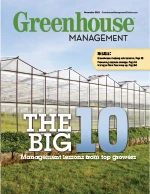 All-America Selections celebrates its 80th anniversary this year, and as part of the celebration, Greenhouse Management will interview a different AAS judge each month to talk about how he or she runs his or her business and what AAS means to them. This is part eight of the 12-part series.
All-America Selections celebrates its 80th anniversary this year, and as part of the celebration, Greenhouse Management will interview a different AAS judge each month to talk about how he or she runs his or her business and what AAS means to them. This is part eight of the 12-part series.
This year alone, Kate Santos and her team at Costa Farms looked at more than 350 petunia varieties for blind comparisons. And that’s just petunias.
 Costa Farms trials plants both by company and by variety so researchers and visitors can view the plant in both settings. Costa Farms trials plants both by company and by variety so researchers and visitors can view the plant in both settings. |
Santos is the director of research and development at Costa, where her team trials more than 3,000 items every year.
“Just on the color side, there were over 600 new introductions that came into the market [this year], so I think our biggest challenge is that there’s so many new introductions that come in every year and where do they go?” she says. “How do you evaluate them? How do you figure out where and if they fit in existing programs and pull out the small percentage that are real game changers and the ones that are incremental improvements over existing lines and series already on the market?”
It’s a huge challenge that’s constantly a work in progress, but what’s been the key to successfully doing those things has been refining the program and how Costa conducts its trials.
“How do you look at this pool of 3,000 items and start to filter it down to the tangibles?” she says. “One of the things we wanted to use as a filter was retail performance because it’s an area people aren’t looking at with any great depth. We’re trying to think outside the box — OK, what do we need to do?”
To start, everything that goes into her trial program gets put into tight spacing before it goes into the garden.
“Let’s look at tight spacing over two weeks,” she says. “What’s the shelf life we can expect for an annual at retail, and which products hold up best at retail?”
The team looks at how it holds up in that time period and how it would look from a consumer perspective.
 “We’ve gotten some pushback on that with regards to how is that fair if you put a geranium that’s a really great garden performer in a small container — that doesn’t do it justice,” she says. “You start coming at different challenges that you face in the different spaces that our products move, and what it’s helped us do is really start to get a better idea of which products held up well at retail and which ones have the trifecta of they meet our production requirements.”
“We’ve gotten some pushback on that with regards to how is that fair if you put a geranium that’s a really great garden performer in a small container — that doesn’t do it justice,” she says. “You start coming at different challenges that you face in the different spaces that our products move, and what it’s helped us do is really start to get a better idea of which products held up well at retail and which ones have the trifecta of they meet our production requirements.”
The team looks at cost, grow time, turns, how they fit in spaces, how they hold up on the retail shelf, including leaf yellowing, if it reblooms and how long it stays in flower. Then the team looks at garden performance. If it meets all these checkpoints, she knows they have a winner.
“Those are the ones we want to focus on, and these are potential really strong candidates that we recommend to our retail partners,” Santos says.
The other challenge is making sure they’re objective in their research.
“The main fundamental objective for our department and what we do is we really try to remove the bias, so whether it’s a blind trial or if we’re doing evaluations, and it’s not blind, we really try to look at it from a performance standpoint,” she says. “What is the objective of the trial? What variables are we looking to evaluate, and what were the results?
“We’re here to advise on the facts, and that gets us out of the politics.”
|
AAS and Costa Farms Kate Santos is the director of research and development at Costa Farms in Miami. She has previously served as the AAS trial judge and is now transitioning that role to another team member. We talked to Santos about why AAS is important to her and Costa. Why did you get involved in AAS? Why is AAS so important to you and the industry? |

Explore the November 2012 Issue
Check out more from this issue and find your next story to read.
Latest from Greenhouse Management
- Meet the Next Gen: Gabriella Blair, Star Roses and Plants
- Leading Women of Horticulture: Katie Dubow, Garden Media Group, and Aubry Field, Lizzy Blossom
- Showing up at your horticulture business as your whole self
- Leading women of Greenhouse Management
- USDA fires experts on invasive pests, including Asian citrus psyllid, chilli thrips
- Farwest Show calls for 2025 New Varieties Showcase entries
- Leading Women of Horticulture: Arden Pontasch, North Creek Nurseries
- Leading Women of Horticulture: Emily Showalter, Willoway Nurseries






